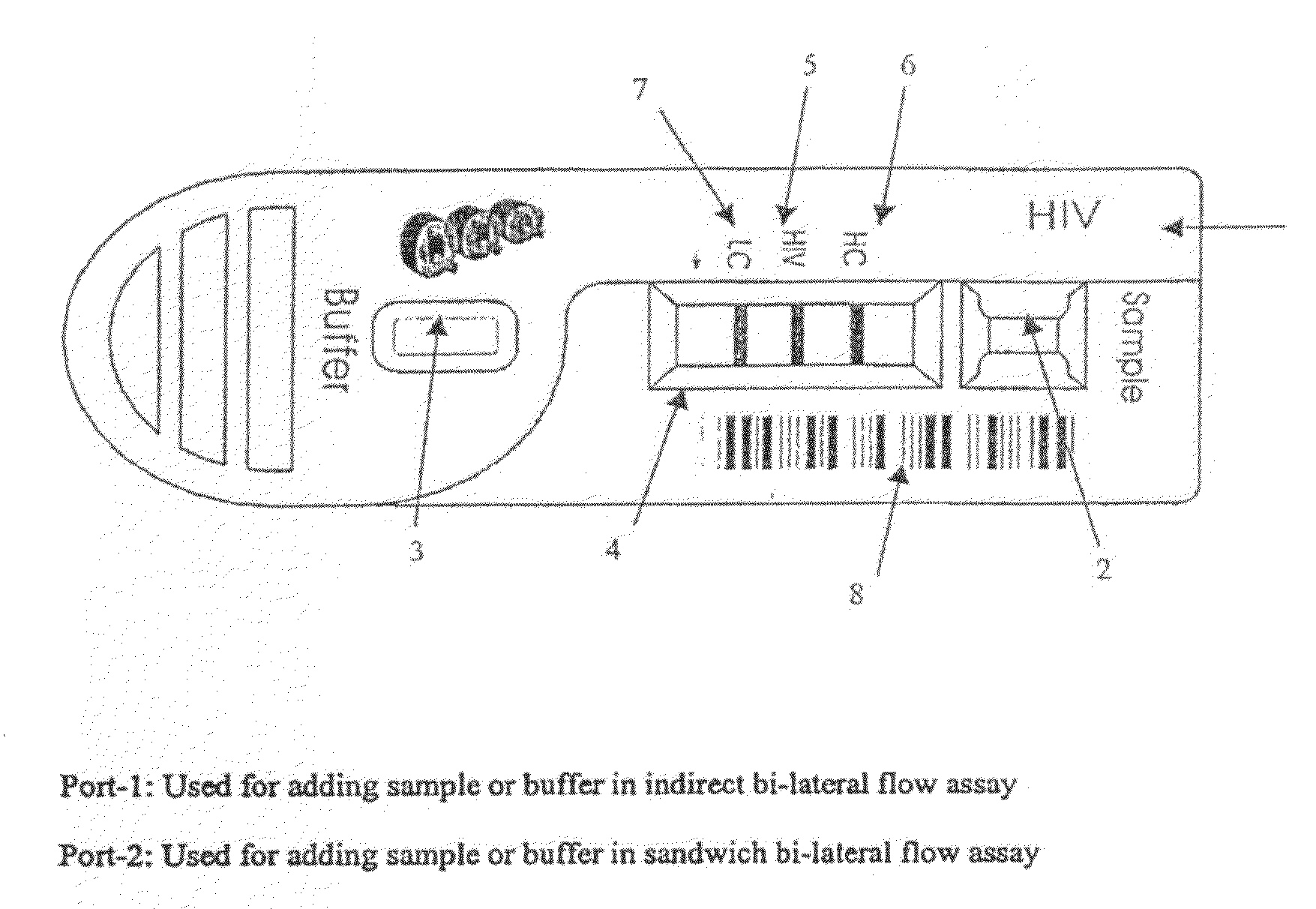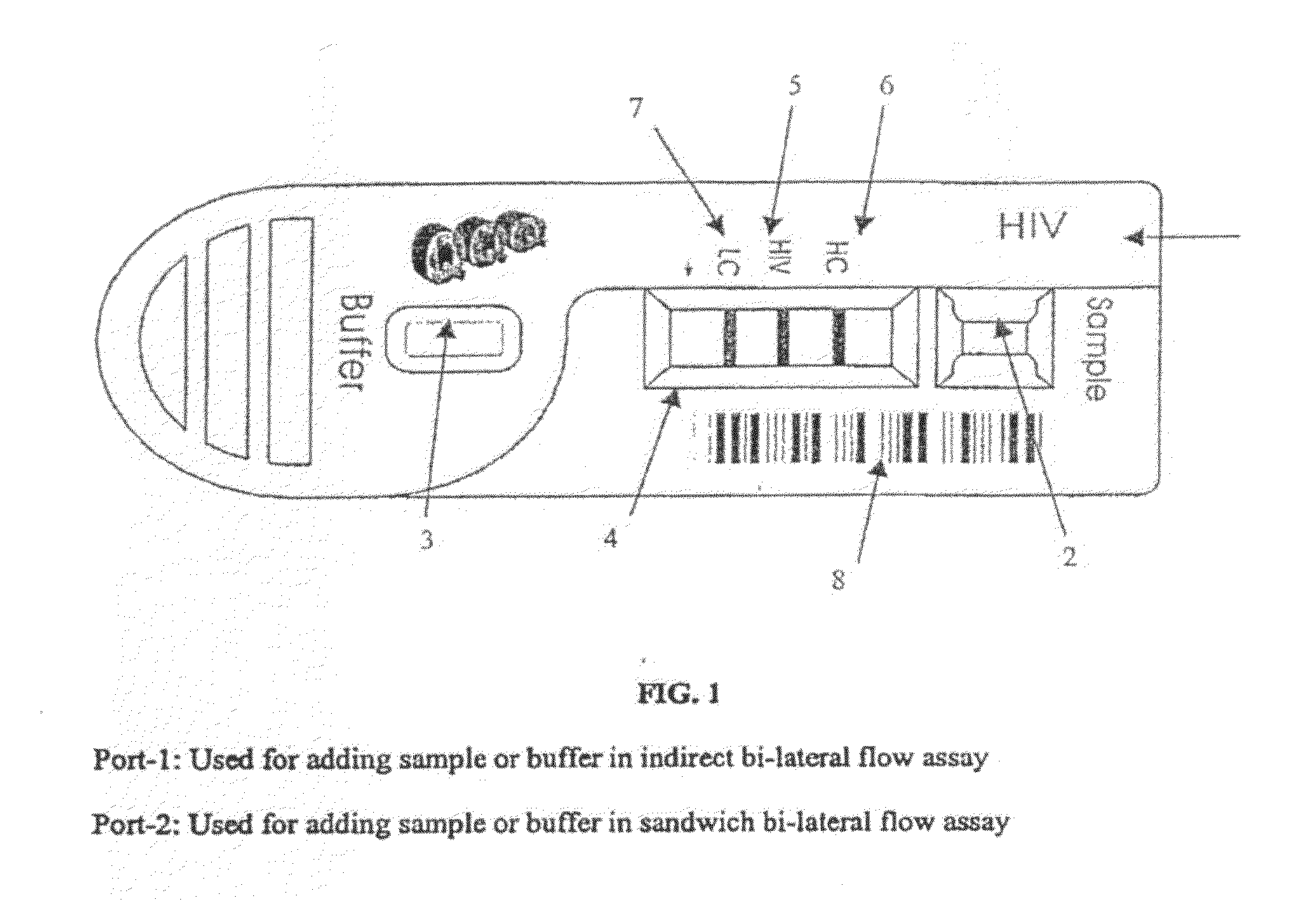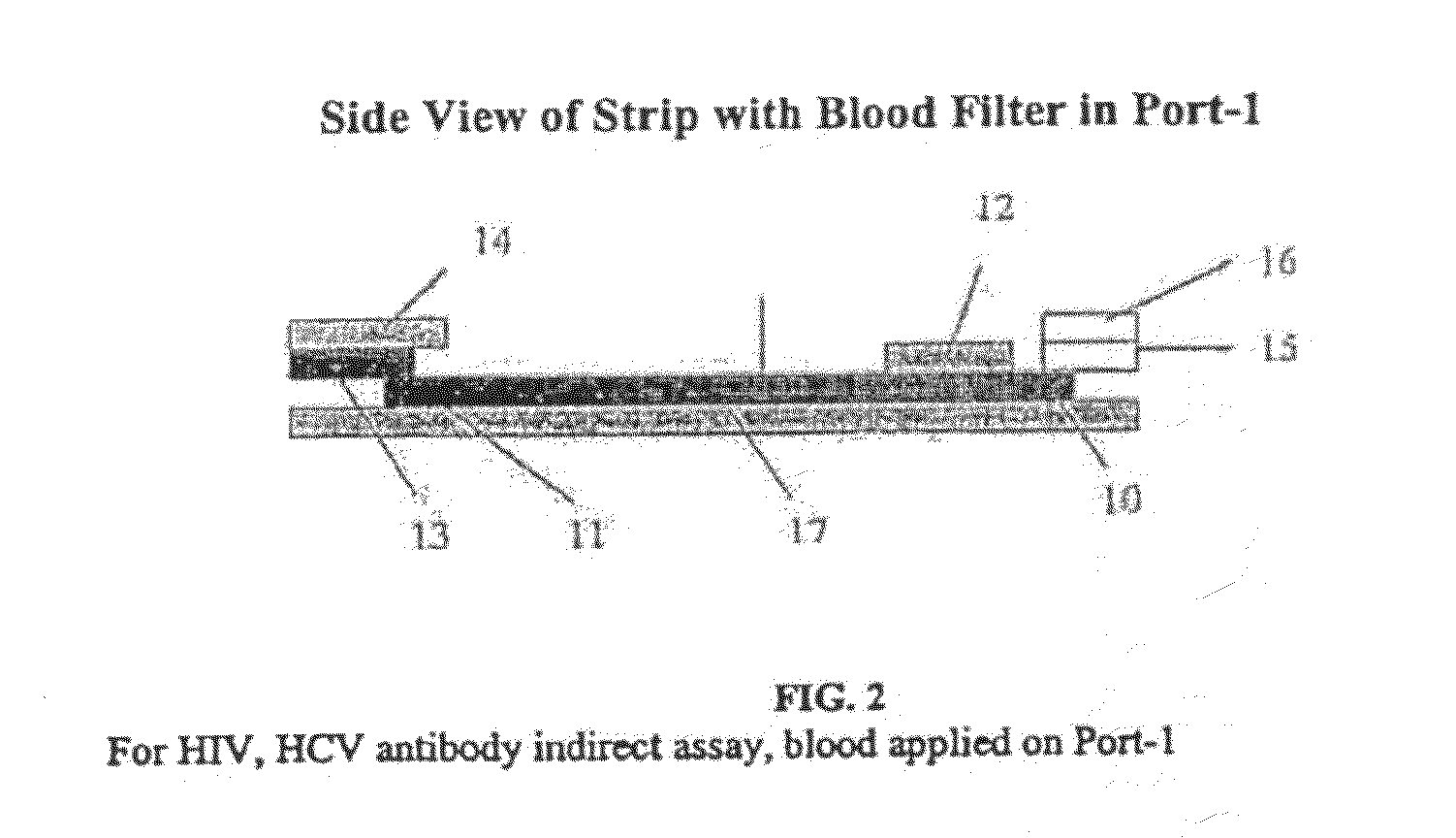Quantitative lateral flow system and assay
a quantitative and lateral flow technology, applied in the field of quantitative and quantitative assay and system, can solve the problems of low efficiency in dissolving a volume variation, long assay time, etc., and achieve the effect of dissolving the conjugate or detectable agent and good cell filtering
- Summary
- Abstract
- Description
- Claims
- Application Information
AI Technical Summary
Benefits of technology
Problems solved by technology
Method used
Image
Examples
example 1
Filtering Capability of Membranes in Absence of Agglutinins
[0195]The test strip as shown in FIG. 2 was constructed with different membranes as the sample filter. The filtering membranes tested were all obtained from Ahlstrom Filtration, Inc. (USA) and include: cellulose absorbent grade 111, glass fibers grade #141 and grade #142, Cytosep grades 1660, 1661, 1662 and 1663. A sample containing whole blood was applied in Port-1 as shown in FIG. 1. The migration speed of plasma on the nitrocellulose chromatographic strip was observed. Results were obtained as set forth in Table 2.
TABLE 2Blood Filtering Membrane Without Anti-hRBCTime of RBCVolumeMigrateappearanceMembraneSampleμlRBC Leakingmm / minBackgroundon NCGrade 111Whole Blood100Yes≦16Red8 minCellulose100Yes≦16Red8 min100Yes≦16Red8 min100Yes≦16Red8 min100Yes≦16Red8 minGrade 141Whole Blood100Yes≦16Red3 minGlass Fiber100Yes≦16Red3 min100Yes≦16Red3 min100Yes≦16Red3 min100Yes≦16Red3 minGrade 142Whole Blood100Yes≦16Red2 minGlass Fiber100Yes...
example 2
Blood Filtering Capability of Membranes Pre-Treated with Anti-RBC
[0196]A ten percent (10%) TWEEN 20 solution was prepared by adding 1 g of TWEEN 20 to 9 ml of deionized water, mixing the solution, and storing the solution for about a week at room temperature.
[0197]A rabbit anti-human red blood cells antibody solution was prepared by adding 9.0825 g of Trizma Base (final concentration of 6.055 g / L), 1.7625 ml of HCl (final concentration of 1.7625 ml / L) and 1.8 g of EDTA.Na2 (final concentration of 1.2 g / L) to 1.35 liters of deionized water. The mixture was stirred slowly until the chemical reagents were dissolved completely, about an hour. The solution was kept at room temperature for 4 hours or overnight at 4° C. The pH of the solution was adjusted to pH 8.5±0.1 by adding HCl. Rabbit anti-human red blood cell antibody (anti-hRBC) was added to the solution to a final concentration of about 0.25 mg / ml. About 0.3 ml of 10% Tween-20 solution was added to the anti-hRBC to a final concent...
example 3
Comparison Between Using Whole Blood Versus Using Plasma
[0199]The test strip as in Example 2 was prepared and whole blood or plasma was added to the sample filter in Port-1 and the results were compared, as shown in Table 4.
TABLE 4Comparison of Testing Results Between Whole Blood and PlasmaRI =Anti-TESThRBCRBCTimeHCLCTESTDr / LCMembraneMg / mlSampleVolumeLeakingminDrDrDrDrS / COResult#1420.25HIV (−)50 μlNo30 min0.17770.0862000(−)0.25Blood50 μlNo30 min0.22680.0967000(−)0.2550 μlNo30 min0.0730.1083000(−)0.2550 μlNo30 min0.1830.0728000(−)0.2550 μlNo30 min0.32770.109000(−)#1420.25HIV (−)50 μlNo15 min0.40330.1926000(−)0.25Plasma50 μlNo15 min0.35870.1945000(−)0.2550 μlNo15 min0.360.1919000(−)0.2550 μlNo15 min0.38220.1955000(−)0.2550 μlNo15 min0.37590.1964000(−)#1420.25HIV (+)50 μlNo30 min0.12130.17810.20141.130811.311(+)0.25Blood50 μlNo30 min0.14190.14410.21811.513515.1325(+)0.2550 μlNo30 min0.17810.14080.21531.529115.2911(+)0.2550 μlNo30 min0.0740.0750.10321.376013.7626(+)0.2550 μlNo30 min0.16...
PUM
| Property | Measurement | Unit |
|---|---|---|
| volume | aaaaa | aaaaa |
| volume | aaaaa | aaaaa |
| volume | aaaaa | aaaaa |
Abstract
Description
Claims
Application Information
 Login to View More
Login to View More - R&D
- Intellectual Property
- Life Sciences
- Materials
- Tech Scout
- Unparalleled Data Quality
- Higher Quality Content
- 60% Fewer Hallucinations
Browse by: Latest US Patents, China's latest patents, Technical Efficacy Thesaurus, Application Domain, Technology Topic, Popular Technical Reports.
© 2025 PatSnap. All rights reserved.Legal|Privacy policy|Modern Slavery Act Transparency Statement|Sitemap|About US| Contact US: help@patsnap.com



